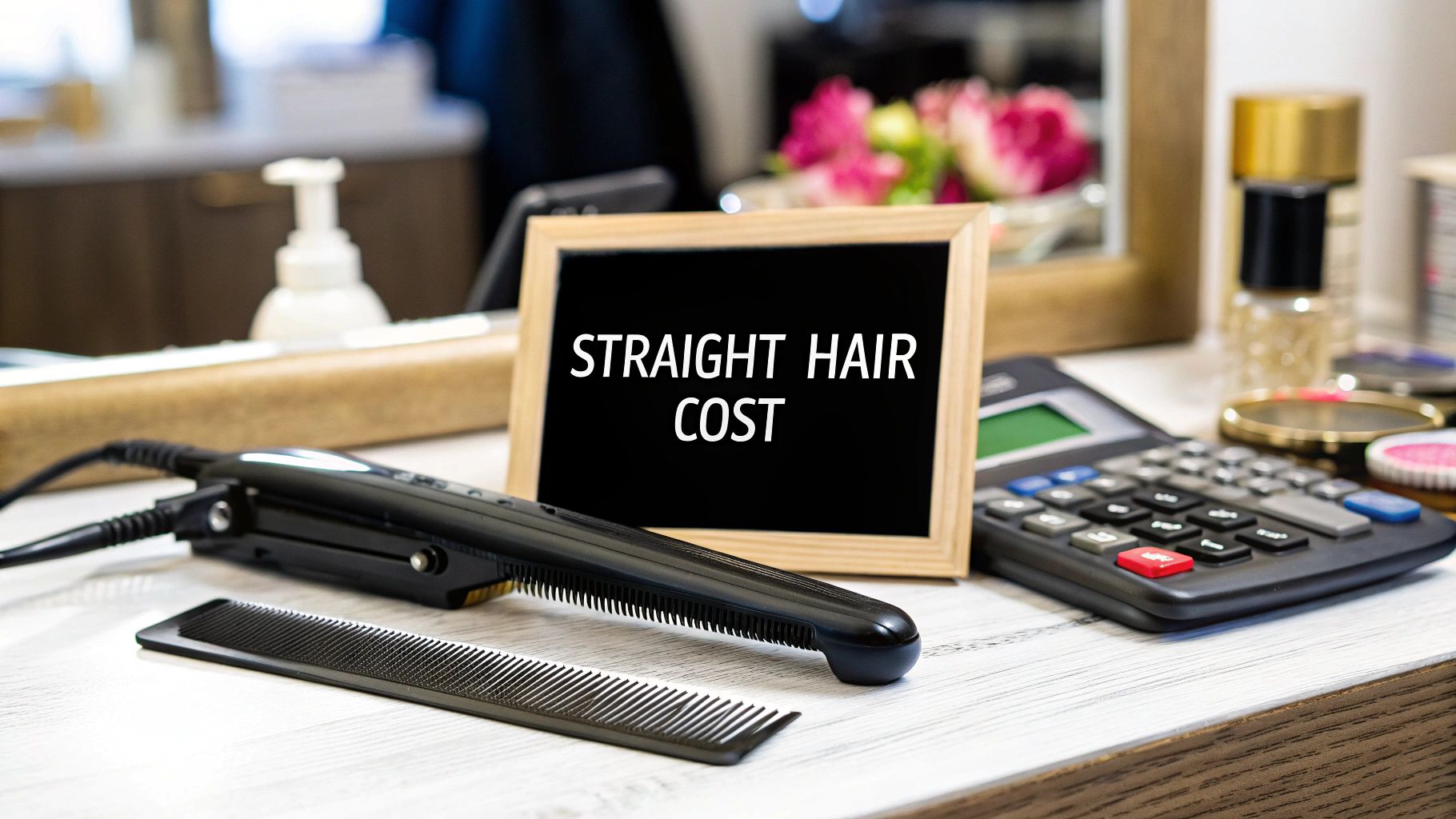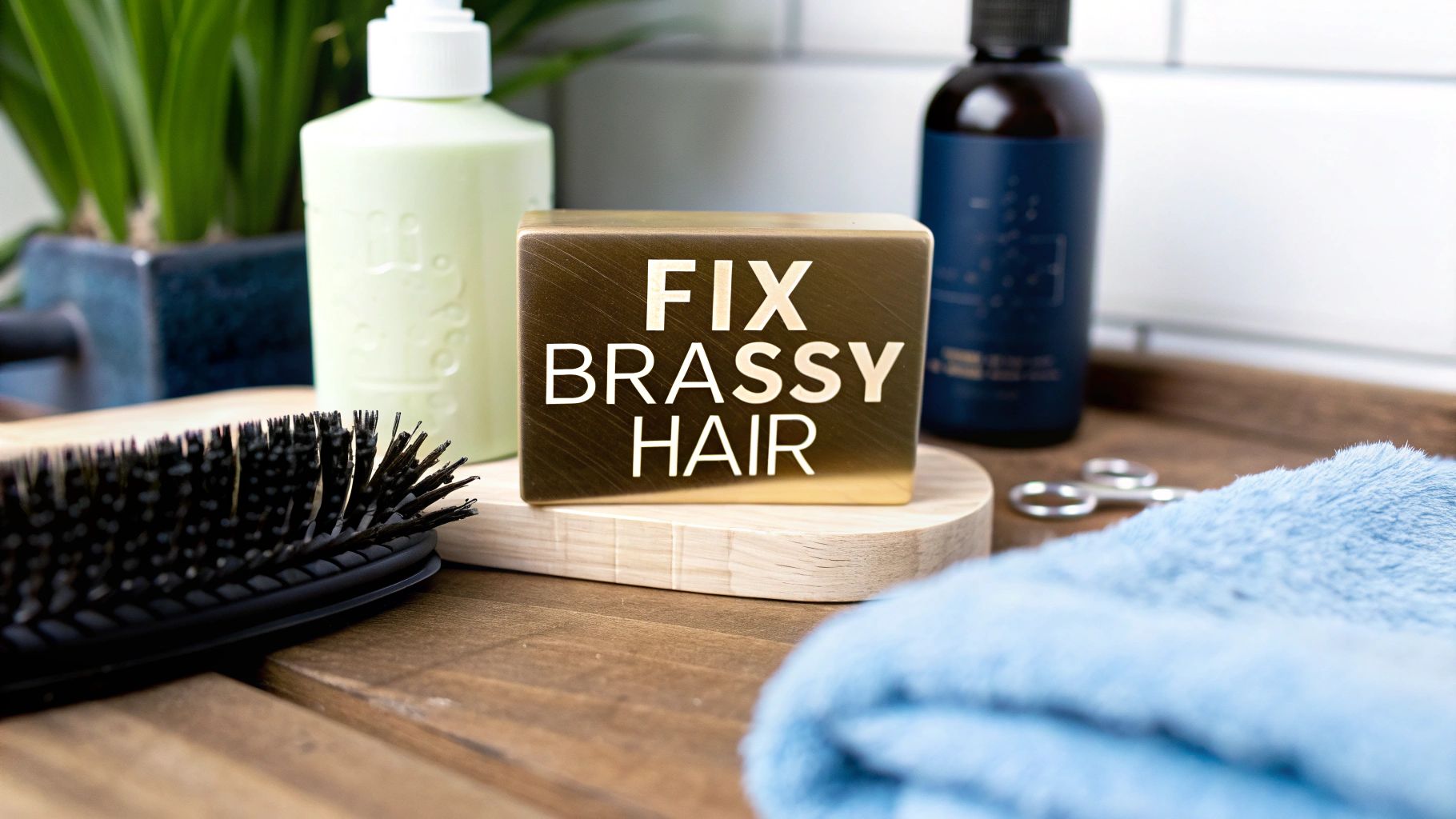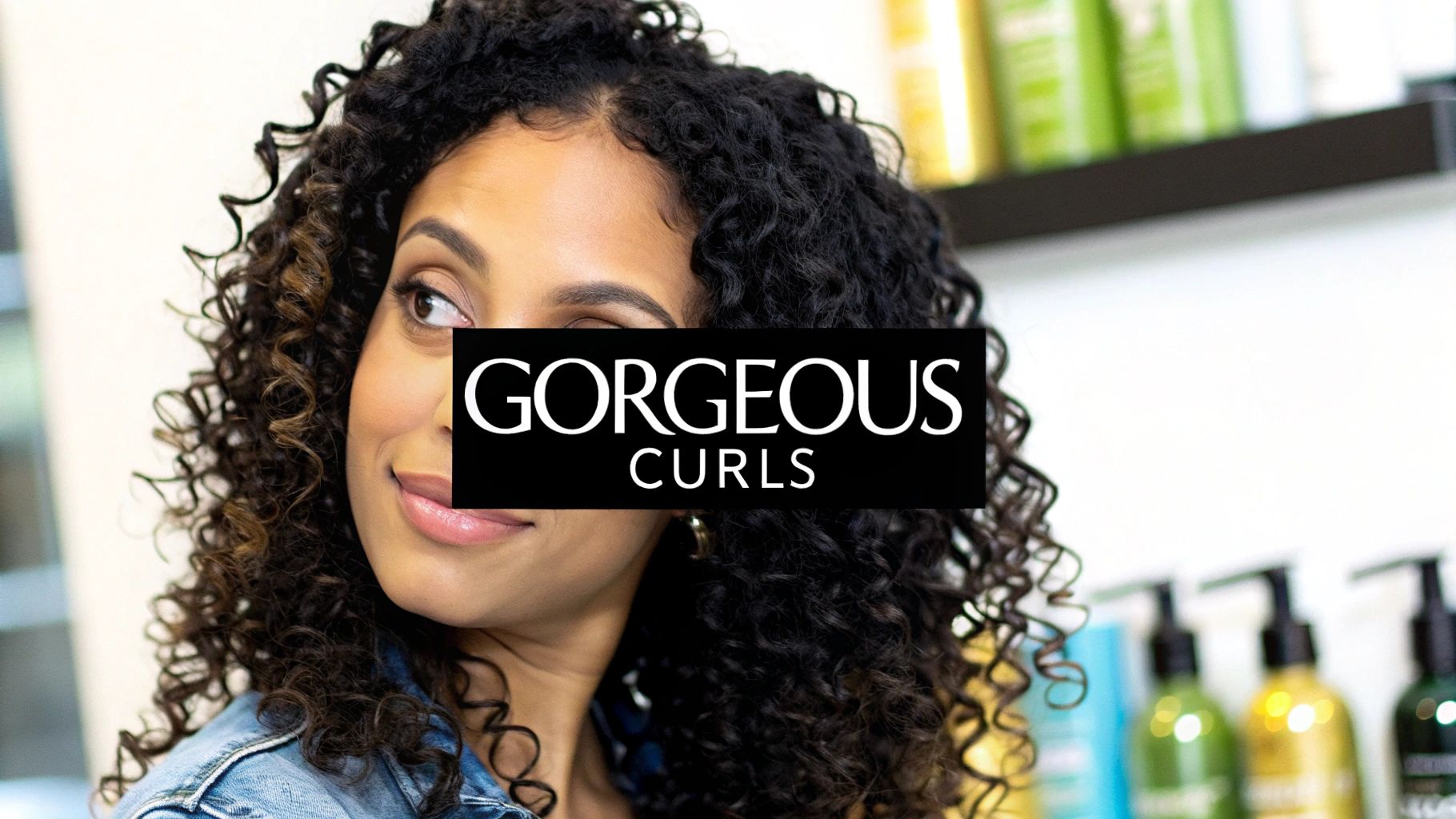So, you're thinking about permanently straightening your hair and wondering what it's going to cost. The short answer is it can run anywhere from $250 to over $800. But the final price tag really depends on what treatment you choose, the salon you go to, and even your own hair.
Thank you for reading this post, don't forget to subscribe!A simpler keratin treatment will be on the lower end of that range, while something more intensive like Japanese straightening will definitely cost you more.
Your Quick Guide to Hair Straightening Costs
Deciding to go for permanently straight hair is a real investment, both in your time and your wallet. The final bill you get isn't just one flat fee; it’s a mix of a few key things: the specific chemical process involved, your stylist's level of experience, and even the city you're in.
It’s a bit like buying a car. You can get a reliable sedan or a high-end sports car. Both will get you where you need to go, but the engineering, the experience, and the price are worlds apart. The same goes for hair straightening—different methods deliver different results and last for different lengths of time, which is all reflected in the cost.
A Snapshot of Average Prices
Once you start looking around, you'll see prices all over the map. The two most popular options, keratin treatments and Japanese straightening, really show this contrast. A quick look at national averages shows that keratin treatments generally fall between $250 and $450.
On the other hand, the more intense and long-lasting Japanese hair straightening averages about $625, with most people paying somewhere between $450 and $800. You can discover more insights about these national averages to get a better handle on budgeting.
This upfront price usually gets you the consultation, the full treatment, and a basic blow-dry. But it's always smart to ask what's included before you book.
The biggest mistake you can make is just assuming the price you're quoted is the final price. Always ask about potential add-ons for extra hair length, thickness, or any pre-treatments you might need. Those extras can easily tack another $50 to $150 onto your bill.
To help you see the full picture, let's break down the main things that make these prices vary so much.
- The Type of Treatment: A semi-permanent keratin treatment is all about smoothing out frizz. But a permanent thermal reconditioning (that's the technical term for Japanese straightening) actually changes your hair's internal structure. The latter takes way more skill and time, hence the higher price.
- Your Hair's Characteristics: This one's simple—the longer and thicker your hair, the more product and time the stylist needs. That extra effort will always show up on the final bill.
- The Salon and Stylist's Reputation: A top-tier stylist in a fancy downtown salon is going to charge a premium for their expertise. It’s just not going to be the same price you'd get from a junior stylist in a smaller, local salon.
Estimated Cost for Popular Hair Straightening Treatments
To make it even easier to compare, here's a quick look at the average costs for the most common straightening treatments you'll find in the U.S. This should give you a solid starting point for figuring out what might work for your budget and your hair.
| Treatment Type | Average Cost Range | Best For | Typical Duration |
|---|---|---|---|
| Keratin Treatment | $250 – $450 | Frizz control, smoothing, and shine | 3 to 6 months |
| Japanese Straightening | $450 – $800 | Pin-straight, permanent results | Permanent (until it grows out) |
| Hair Relaxer | $150 – $350 | Coarse, curly, or coily hair types | Permanent (until it grows out) |
| Brazilian Blowout | $200 – $500 | Reducing frizz and volume, enhancing shine | Up to 4 months |
Keep in mind these are just general estimates. The final cost will always come down to the specific factors we've talked about, especially your salon's location and your hair's unique needs.
Comparing Major Straightening Treatments and Their Prices
Picking the right straightening treatment is a bit like choosing a new coat. Some are like lightweight rain jackets, perfect for taming frizz for a little while. Others are heavy-duty winter parkas, built to create a permanent change. The permanently straightened hair cost you’ll pay is a direct reflection of how intense—and how long-lasting—your chosen treatment is.
Let's break down the most popular options out there.
This visual gives a great overview of the different factors that play into the final price tag.

As you can see, what you ultimately pay is a mix of the treatment itself, your hair’s specific needs, and the skill of the person holding the flat iron.
Japanese Straightening (Thermal Reconditioning)
Think of Japanese straightening as a complete architectural rebuild of your hair. This is an intensive process that uses a one-two punch of chemicals and high heat to permanently break down and then restructure the protein bonds inside every single strand. The result? A perfectly pin-straight finish.
- Best For: This is the go-to for someone with healthy, untreated hair who wants a dramatic, permanent switch from curly or wavy to completely straight.
- The Process: Settle in, because this is a serious salon commitment. You can expect to be in the chair for 4 to 8 hours. A stylist will apply a solution that breaks down your hair's natural bonds, meticulously flat iron every section, and then lock in the new straight structure with a neutralizer.
- Cost & Longevity: Because it's so complex and time-consuming, this is one of the priciest treatments available, usually running from $450 to $800. The results are permanent on the hair that’s been treated. Of course, your hair will keep growing, so you'll need to come back for root touch-ups every 6 to 12 months.
Keratin Treatments (Brazilian Blowout)
A keratin treatment isn’t a permanent structural change like Japanese straightening. It’s more like wrapping your hair in a super-smooth, protective shield. The process infuses natural keratin protein back into the porous, damaged parts of your hair, which tames frizz, cuts down on blow-dry time, and adds a ton of shine.
Your hair will be smoother and way more manageable, but it will still have some of its natural body and movement. These treatments are semi-permanent, so the effects will gradually fade over a few months. If you want to dive deeper into the specifics, you can explore the key differences between Keratin and a Brazilian Blowout in our guide.
Here’s the main thing to remember: Keratin treatments work on the outside of the hair, smoothing the cuticle. Japanese straightening works on the inside, permanently changing its bonds. That fundamental difference is why there’s such a big gap in cost and longevity.
Chemical Relaxers
This is a more traditional route to straight hair. Chemical relaxers rely on powerful ingredients like sodium hydroxide to break down the hair’s protein bonds, effectively "relaxing" the curl pattern. It’s a highly effective method, especially for very coarse or coily hair types.
- Best For: This is a solid choice for coarse, curly, or coily textures that just don't respond well to other methods.
- The Process: A creamy relaxer is applied to the hair and left to process for a short time to break the bonds. It's then rinsed out and neutralized. It’s a much quicker process than Japanese straightening, typically taking just 1 to 2 hours.
- Cost & Longevity: Relaxers are often the most budget-friendly option, with salon services usually landing between $150 and $350. The results are permanent, just like Japanese straightening, which means you'll need to schedule touch-ups for new growth every 8 to 12 weeks.
What Really Determines Your Final Salon Bill

Ever wonder why your friend paid $300 for a keratin treatment, but the salon down the street quoted you $700 for what seems like the exact same service? It can feel a bit arbitrary, but there's a method to the madness. The final number on your bill for permanently straightened hair is a highly personalized quote, not a simple menu price.
Think of it like getting a custom suit made. The tailor's reputation and the shop's location set a baseline price. But the final cost really depends on the fabric you choose, how much of it is needed, and the intricate work required to make it fit you perfectly. Your hair is the fabric, and the stylist is the master tailor.
The Salon and Stylist Factor
First things first, where you go matters. A high-end salon in a prime San Francisco neighborhood has enormous overhead costs—rent, utilities, top-shelf products, and staff training. Those expenses are baked into their pricing structure, setting the starting point for any service.
Then there’s the artist holding the brush. A master stylist with a decade of experience and a wall of certifications will charge more than a junior stylist. You aren't just paying for their time; you're paying for their hard-won expertise, their precise application, and their deep understanding of how to protect your hair's integrity throughout a demanding chemical process. The best salon management software helps salons streamline these complex pricing structures, but the core principle remains: you’re investing in skill and quality.
Your final bill is a direct reflection of two things: the salon's operational costs and the specific resources—both product and time—required to transform your unique hair.
Your Hair’s Unique Blueprint
Beyond the salon's doors, the single biggest variable is you. Your hair's length, thickness, and current condition are what truly drive the final price, dictating how much product is used and how many hours you'll be in the chair.
- Hair Length and Density: It’s simple math. A fine, shoulder-length bob needs way less straightening solution and time than thick, waist-length curls. More hair means more product, more careful sectioning, and more time meticulously passing the flat iron over every single strand.
- Hair Condition: Is your hair color-treated, a bit stressed, or in great shape? A good stylist will often need to perform a pre-treatment or use a gentler, more time-consuming technique on compromised hair. This extra care can add to the service time and, consequently, the cost.
- Curl Pattern: Straightening out a loose, gentle wave is a much simpler task than taming tight, springy coils. The curlier your natural texture, the more intensive the labor becomes to get that perfectly sleek, uniform finish.
Globally, this is why you see such a massive price range for popular services like keratin treatments, which often fall somewhere between $200 and $600. That huge gap is almost entirely explained by the combination of your hair’s specific needs and the stylist’s level of expertise. While at-home kits might seem tempting, they can't account for these critical variables, which is where professional precision becomes non-negotiable for a safe, beautiful outcome.
How Your Location Impacts Hair Straightening Prices
Where you live plays a massive role in what you'll pay to get your hair permanently straightened. It’s a lot like real estate, honestly. A salon in downtown San Francisco has to cover astronomical rent, while one in a quiet suburb doesn't. That difference in overhead trickles right down to the price of every service, from a simple haircut to a full-on straightening treatment.
Think about it. A top-tier salon in a place like New York or Los Angeles is juggling incredibly high costs. We're talking about rent that could make your eyes water, premium utility bills, and the need to offer competitive salaries to keep the best stylists from going elsewhere. All of that gets baked into the final price you see on the menu.
Because of this, the permanently straightened hair cost can swing wildly depending on your zip code. A stylist in a smaller town can deliver the exact same quality work for a fraction of the cost, purely because their monthly expenses are so much lower.
Big City Premiums Versus Small Town Savings
And we're not just talking about a few bucks here—the difference can be significant. The price for a keratin treatment in a major city center can easily be 30-50% higher than what you'd find at a salon just an hour away in the suburbs. It’s not just the rent; it's also about local demand and what the market is willing to pay for highly skilled work.
Let’s break down what this looks like on the ground.
- Major Urban Centers: Cities like San Francisco, NYC, and LA are notorious for having the highest salon prices in the country. This is a direct result of the high cost of living and a large client base ready to pay for premium services.
- Suburban and Mid-Sized Cities: This is often the sweet spot. You get access to talented stylists and quality products, but the salon’s lower overhead means the pricing is far more reasonable.
- Rural Areas: You'll likely find the lowest prices out here. The trade-off, however, might be a smaller selection of stylists who specialize in complex chemical treatments like Japanese straightening.
This isn't just a hunch; it's a documented trend. Data from 2020 showed that Japanese hair straightening could cost as little as $123 in Texas but jump all the way to $425 in New York. You can dig into these state-by-state cost differences on StyleSeat.com.
This pricing pattern isn't exclusive to straightening, either. We see the same thing across other specialized services, which we cover in our guide to curly hair salon prices. Knowing this ahead of time helps you set a realistic budget so you don't get sticker shock when a salon's quote is way off from what you found online.
Budgeting For Long-Term Maintenance And Aftercare
Getting your hair permanently straightened is only half the investment. The salon fee grabs the headlines, but the real commitment begins the moment you walk out with sleek, shiny locks.
Think of your treatment like purchasing a high-performance car. The sticker price is just the start—you’ll also need specialized fuel, premium oil changes, and routine tune-ups to keep it running smoothly. In the same way, your newly straightened hair demands a tailored upkeep routine that goes beyond your old bathroom-cabinet staples.
Old shampoos and conditioners—packed with sulfates—can literally wash your straightening treatment away. To protect your results and maintain your hair’s health, it’s time to upgrade to a suite of products made for chemically treated strands.
The Essential Aftercare Toolkit
Protecting your investment means refreshing your daily lineup. Budget $60 to $120 right off the bat for these must-have items:
- Sulfate-Free Shampoo & Conditioner: Gentle cleansers preserve your treatment instead of stripping it away.
- Weekly Deep-Conditioning Mask: Chemical processes can leave hair thirsty. A rich mask restores moisture and elasticity.
- Heat Protectant Spray: Flat irons and blow dryers still come into play. A quality protectant shields your hair from high temperatures.
The single biggest mistake after a straightening treatment is reverting to old, harsh hair products. Replacing a faded treatment often costs far more than investing in a good sulfate-free shampoo.
Factoring In Root Touch-Ups
As your hair grows, new roots will contrast with your treated lengths. For permanent methods—like Japanese straightening or chemical relaxers—touch-ups become essential.
- Frequency: Every 6 to 12 months, depending on your hair’s growth rate.
- Cost: Typically 50–70% of the original service price.
- Annual Budget Range: $250 to $500 for seamless, all-over straightness.
On top of that, those with naturally curly hair often learn new styling tricks as fresh growth appears. You can find practical tips in our guide on how to style curly hair.
To make these numbers clearer, here’s a sample breakdown of yearly maintenance costs—excluding the initial treatment fee.
Sample Annual Maintenance Budget for Straightened Hair
An estimated breakdown of the yearly costs associated with maintaining straightened hair, not including the initial treatment.
| Maintenance Item | Frequency | Estimated Annual Cost |
|---|---|---|
| Sulfate-Free Shampoo & Conditioner | Daily Use | $120 |
| Deep-Conditioning Mask | Weekly | $180 |
| Heat Protectant Spray | As Needed | $60 |
| Root Touch-Ups | Every 6–12 Months | $350 |
| Trim or Restore Treatment | Every 3–4 Months | $200 |
| Total Estimated Cost | $910 |
Every item in this table plays a role in prolonging your straightened style. By planning for each product and salon visit, you turn unpredictable expenses into a predictable annual budget—letting you enjoy glossy, manageable hair year-round.
Is the Investment in Straight Hair Worth It for You?
After breaking down the treatments, potential add-ons, and long-term upkeep, we get to the real heart of the matter: is the permanently straightened hair cost a smart move for you? The answer isn't on a salon's price menu. It's a personal decision that weighs the price tag against your daily life.
Think about it this way: this isn't just about paying for a service. It's an investment in your time, your confidence, and your sanity.
How many hours a week do you spend fighting frizz or clamped to a flat iron? For many people, getting that time back is the biggest win. Imagine just waking up, running a brush through your hair, and walking out the door. That kind of ease can honestly change your whole morning routine, and it's tough to put a price on that.

Making a Confident Decision
Ultimately, you’re balancing the total financial commitment with your lifestyle and what you want for your hair. If you’re constantly at war with your natural texture and dream of that wash-and-go sleek look, the cost might feel completely justified. On the other hand, if you generally like your hair and just want it straight sometimes, the investment probably doesn’t make sense.
By weighing the total cost against the value of time saved and confidence gained, you can make a clear-headed decision that aligns perfectly with your budget and lifestyle.
The best way to invest wisely is to find a stylist you trust. A thorough, expert consultation is your most important tool here. A great stylist will look at your hair's health, listen to your goals, and give you a transparent, all-in price so you know exactly what you’re getting into.
Before you take the plunge, be sure to ask these questions during your consultation:
- What’s the total estimated cost, including any extras for my hair's length or thickness?
- Looking at my hair, which specific treatment do you recommend and why?
- What does the maintenance really look like? What products will I need, and how often will I need touch-ups?
Getting straight answers to these questions helps you walk into the salon with your eyes wide open. It turns a simple hair appointment into a smart, long-term investment in yourself.
Frequently Asked Questions
When you're thinking about a big change like permanent hair straightening, a lot of questions come up, especially around the price and how long it will last. Let's clear up some of the most common things people ask.
How Does Hair Type Affect the Price?
It's one of the first questions I get: "Does it cost more if my hair is super thick or curly?" The short answer is yes, almost always.
Think of it this way: painting a small, smooth wall is a quick job. But painting a much larger, textured wall? That's going to take a lot more paint and a lot more of your time to get the job done right.
Hair works the same way. Thicker, longer, or very curly hair requires a lot more of the straightening solution to saturate every strand. It also takes your stylist significantly more time to meticulously apply the product and flat iron each section. This extra time and product directly translate to a higher cost, sometimes bumping the price up by 50% or more compared to someone with fine, shorter hair.
Your hair’s unique blueprint—its length, density, and curl pattern—is the single biggest variable in your final bill. More hair always means more time and more product.
What Is the Touch-Up Schedule and Cost?
So, how often do you have to come back? That really depends on two things: how fast your hair grows and which type of straightening treatment you chose. The upkeep for a truly permanent treatment is different from a semi-permanent one.
- Japanese Straightening: Since this permanently alters your hair, the treated sections stay straight forever. You’ll just need to come in for a root touch-up every 6 to 12 months to straighten the new growth.
- Keratin Treatments: These are more of a long-term smoothing system. They gradually wash out over 3 to 6 months, which means you'll need the full treatment redone, not just a root touch-up.
Are There Ways to Find a Discount?
Everyone loves a good deal, and it's definitely possible to find one. Many salons will offer a discount for first-time clients, create package deals if you buy several sessions upfront, or run promotions during their slower seasons. It never hurts to just ask what specials they have going on.
A word of caution, though: be wary of deals that seem too good to be true. These are complex chemical services, and you're paying for your stylist's skill and the quality of the products they use. For more answers to common questions about different beauty treatments, a salon's general FAQs about salon services can be a great resource.



